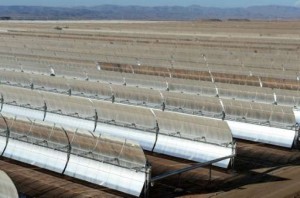The News International pk
On the edge of the Sahara desert, engineers make final checks to a sea of metal mirrors turned towards the sun, preparing for the launch of Morocco’s first solar power plant.
The ambitious project is part of the North African country’s goal of boosting its clean energy output with what it says will eventually be the world’s largest solar power production facility.
Morocco has scarce oil and gas reserves, and is the biggest importer of energy in the Middle East and North Africa.
The plant is part of a vision to move beyond this heavy dependency and raise renewable energy production to 42 percent of its total power needs by 2020.
About 20 kilometres outside Ouarzazate, half a million U-shaped mirrors — called “parabolic troughs” — stretch out in 800 rows, slowly following the sun as it moves across the sky.
Spread over an area equivalent to more than 600 football pitches, they store thermal energy from the sun’s rays and use it to activate steam turbines that produce electricity.
King Mohamed VI launched construction of the plant, called Noor 1, in 2013, at a cost of 600 million euros and involving roughly 1,000 workers.
Its start of operations by the end of this month was set to coincide with the conclusion of high-stakes COP21 global climate talks in Paris.
“Construction work has finished,” said Obaid Amran, a board member of Morocco’s solar power agency.
“We are testing components of the production units with a view to connecting them to the national grid at the end of the year.”
The project’s next phases — Noor 2 and Noor 3 — are to follow in 2016 and 2017, and a call for tenders is open for Noor 4.
Once all phases are complete, Noor will be “the largest solar power production facility in the world”, its developers say, covering an area of 30 square kilometres.
It will generate 580 megawatts and provide electricity to a million homes.
The solar power project will also help reduce the country’s greenhouse gas emissions.
The energy ministry estimates that its first solar power plant will allow the country to reduce CO2 emissions by 240,000 tonnes per year initially, and by 522,000 tonnes with the second two phases.
That is equivalent to nearly one percent of Morocco’s CO2 emissions of around 56.5 million tonnes in 2011, according to World Bank figures.
The so-called “greenhouse effect” is a natural phenomenon — an invisible blanket of gases including small amounts of carbon dioxide (CO2) — that has made Earth warm enough for humans to survive on it comfortably.
But human activities such as burning coal and oil inject additional CO2 into the atmosphere, leading to global warming.
Humanity’s annual output of greenhouse gases is higher than ever, totalling just under 53 billion tonnes of CO2 in 2014, according to the UN.








